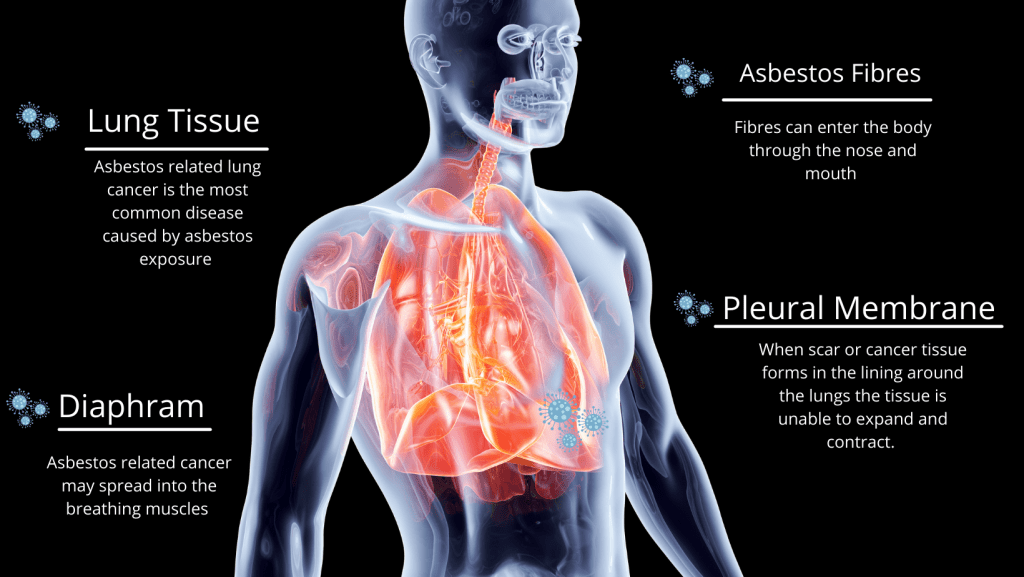Smart Asbestos Services shed some light on the health implications of asbestos exposure and what the results of this could be. With over 25 years of experience in Asbestos Removal, we understand how scary it is when you accidentally disturb asbestos and the thoughts which enter your head. Our guide is comprehensive, and the facts within it have been verified. It’s designed to give you, the reader, a better understanding of how and when asbestos exposure could affect you.
Asbestos is a dangerous material and should be avoided. However, people who have had contact with asbestos do not always develop health implications. The risk of disease is based on many factors including:
- How much time has passed since they were exposed to asbestos
- How much asbestos is in the air
- How often and for how long does exposure occur
- Whether the person already has lung or breathing conditions and
- Whether the person smokes tobacco
Asbestos in the workplace is the No 1 cause of asbestos-related disease. Asbestos exposure also occurs in the home.
When am I most at risk of asbestos exposure?
For domestic properties/homeowners:
- Where the property was built before 2000 it is likely it may contain asbestos materials. Should you carry out renovations on your home, it is always best to get any suspected material tested prior to trying to remove it yourself
- Who are having building/renovation (in buildings built prior to 2000) works completed on their home, they could be at risk of asbestos exposure if the tradesmen have not identified potential asbestos prior to carrying out the work
- Where a home buyers surveys did not identify asbestos
- Where you decide to carry out asbestos removal works yourself but you have not received the correct information or training to carry this out
- Where rouge traders are used and are not trained to identify, remove or dispose of asbestos safely and correctly.
For tradesmen/employees
- When working on homes which were built before 2000 and an asbestos survey has not been completed
- When working on an unfamiliar site where no risk assessments or asbestos surveys have been completed, therefore asbestos materials have not been identified prior to starting the works
- Where asbestos materials were identified but this information has not been passed onto you
- Where you have not completed a risk assessment yourself
- Where you have not undertaken the correct training and received the correct information and instruction on asbestos. This is particularly important when you do not know how to identify asbestos
Secondary asbestos exposure
Secondary asbestos exposure occurs when asbestos fibres are brought home by people who work with asbestos. This type of exposure is just as dangerous as primary asbestos exposure. Before strict regulations were enforced it was common for asbestos workers to unknowingly bring asbestos home on their work clothes, shoes, hair and skin. More commonly now, where work with asbestos is carried out, strict rules and protective equipment are enforced to prevent this.
How does asbestos exposure happen?
Asbestos exposure happens when the microscopic fibres become airborne, placing anyone nearby in danger of inhaling or ingesting it.
Asbestos fibres are light, therefore they may settle within 48-72 hours, however, any disturbance would make them airborne again – leading to more risk of exposure. This is why it is important to have your asbestos removed by professionally trained asbestos removal companies and not try and tackle it yourself. Trained companies will ensure that dust suppression techniques are used to minimise the spread of asbestos fibres in the air.
In general, most people are exposed to asbestos through their occupations. Trades such as construction, plumbing, electricians, heating & ventilation engineers, and roofing contractors, where manual work with asbestos is required, are at the highest risk of asbestos exposure. In the home, airborne fibres from asbestos can be released when renovations or DIY works are being carried out on houses built prior to 2000.
Where might asbestos be found in the home?

What are the health implications of asbestos exposure?

If asbestos fibres are inhaled or ingested they can become trapped in the body’s respiratory or digestive system. Many fibres become stuck whilst a small amount is expelled by the body.
There is no safe level of asbestos exposure, even one-time extreme asbestos exposure can cause disease. However, most problems arise after years of exposure. Combining smoking with asbestos exposure gives a greater risk of lung cancer. It can take anywhere between 10-70 years after the initial exposure to develop problems.
Cancerous conditions
Mesothelioma: This is a rare and incurable cancer that develops in the lining of the lungs or abdomen.
Lung Cancer: This is the same as lung cancer caused by smoking and causes.
Non-cancerous conditions
Asbestosis: Inflammation and scarring of lung tissue, which prevents the lungs from expanding and relaxing normally.
Pleural plaques: Areas of fibrous thickening of the lining around the lungs — the most common sign of asbestos exposure.
For more information on the risks and dangers of asbestos exposure visit the HSE Website
Important Facts
- You cannot see or smell asbestos fibres
- Avoid breathing asbestos in – it may take many years for the symptoms of asbestos exposure to develop
- Smoking greatly increases the risk of lung cancer in people who are exposed to asbestos
- Asbestos is only dangerous when fibres are released and breathed in. If the asbestos is in good condition and not at risk of being damaged or disturbed then it is best left where it is
Frequently Asked Questions
Can I get cancer from asbestos exposure?
Mesothelioma is primarily caused by asbestos exposure. With there being no safe limit of asbestos exposure, the fibres could cause cancer.
What should you do if exposed to asbestos?
If you have been exposed to asbestos and are experiencing symptoms of Mesothelioma or other asbestos-related diseases you should contact your doctor immediately
How much exposure is harmful?
There is no safe limit of exposure to asbestos. In extreme cases, just one-time exposure can lead to asbestos-related disease. Always ensure you get your asbestos removed professionally by adequately trained operatives.
Can you be exposed to asbestos from someone else?
Secondary asbestos exposure occurs when asbestos fibres are carried by someone else. As an example, workers who bring asbestos home on their clothes can unknowingly increase the risk of family members to asbestos-related diseases
Need some advice about Asbestos waste?
Call us on 01623 272 611 and we'll be happy to help
